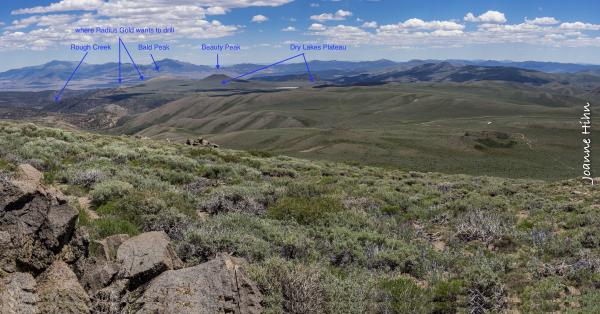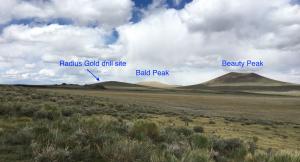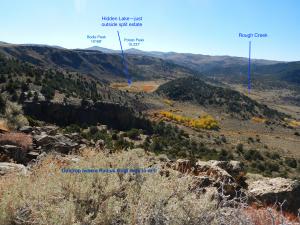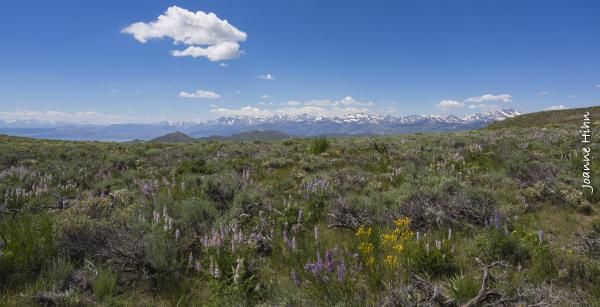
There were two Radius Gold exploratory drilling projects started in the Bodie Hills. One started in 2017 on the Nevada side of the Dry Lakes Plateau and the other in 2019 on the California side of the Dry Lakes Plateau. Both were called Bald Peak and both projects were exploring the same hydrothermally altered rock that was a hot spring millions of years ago (called a sinter). There is evidence of fine grained gold particles in the rocks at the surface. Radius Gold was looking for a gold vein deep down that would have been the source of the gold that they see on the surface.
Why There's Gold in the Bodie Hills
Gold exploration companies have searched the Bodie Hills for the hydrothermally altered rock areas. They look for ancient hot springs, pools, and geyser vent mounds long solidified into rock called sinter terraces. If they find gold in those rocks, then they assume the gold came up with the hot water from veins of gold below. There are three mining districts in the Bodie Hills (Masonic, Bodie, and Aurora) and nine alteration zones. The mining districts have been played out, but the alteration zones are still attracting prospectors. The Paramount Mine was mined for mercury in the form of cinnabar in 1878, 1941-1944, and 1968. Antimony and arsenic are also present in this alteration zone. In recent decades, gold seekers have been eyeing the Paramount-Bald Peak alteration zone for gold; not mercury: Homestake, Molycorp, Noranda, Equinox, Cougar Gold and now RadiusMost of the gold present in the Bodie Hills came with volcanic eruptions that occurred from 15 to 5.5 million years ago covering the area with lava, lava domes and stratovolcanoes like Mt. Biedeman and Masonic Mountain. It is called the Bodie Hills volcanic field. It formed when the Farallon Plate was subducted beneath the North American Plate and is part of the ancestral Cascades arc. There were numerous hydrothermal systems during this era that altered the rock and left mineral deposits with gold, silver, and mercury. The Bodie and Aurora mining potential was discovered millions of years later during the California Gold Rush.
 Radius Gold is the third gold prospecting company that has requested to do exploratory drilling at this site. Homestake requested an exploratory drilling permit in 1984, but stopped after collecting hand samples. In December 1989 Deloro applied for a hand-sampling permit and then asked the State Lands Commission for a permit to do exploratory drilling in May 2000. Deloro’s hand sample with the highest concentration of gold was 8650 ppb. That is 0.278 oz of gold, but in a ton of dirt! At the time that amount of gold was worth about $80. Now that same amount of gold is worth $482. Deloro withdrew their application in June 2000, right after a public site visit where many people showed up. Deloro’s backers didn’t like the mounting opposition and the public’s push for an environmental impact report.
Radius Gold is the third gold prospecting company that has requested to do exploratory drilling at this site. Homestake requested an exploratory drilling permit in 1984, but stopped after collecting hand samples. In December 1989 Deloro applied for a hand-sampling permit and then asked the State Lands Commission for a permit to do exploratory drilling in May 2000. Deloro’s hand sample with the highest concentration of gold was 8650 ppb. That is 0.278 oz of gold, but in a ton of dirt! At the time that amount of gold was worth about $80. Now that same amount of gold is worth $482. Deloro withdrew their application in June 2000, right after a public site visit where many people showed up. Deloro’s backers didn’t like the mounting opposition and the public’s push for an environmental impact report.
This USGS paper has more information about the gold and silver potential in the Bodie Hills and there's one on the geology of the Bodie Hills too.
Radius Gold's two Projects

Bald Peak (CA) Gold Exploration: In 2019 Radius Gold received a hand-collecting permit on a property in the Bodie Hills on the Dry Lakes Plateau near Beauty Peak from the State of California and wants to do exploratory drilling there. At the same time, Radius Gold submitted an application for a special use permit to Mono County to do exploratory drilling in the Bodie Hills. This property was a state school lands property that was bought by the Hilton family long ago and recently sold to the Hunewill family. The state retained the mineral rights and can lease them. Radius Gold has the right to “reasonable access” to the mining site. They were proposing helicopter access for the equipment, but would also drive to the site from the Bodie State Park across the Dry Lakes. Biggest concerns/issues are: sage grouse impacts, source of the water for drilling, roads in the WSA, and disturbance of cultural resources. Radius Gold withdrew their application in July 2020 due to COVID and higher priorities. As of August 2020, they had not formally amended their California State Lands application and even if they do, they may be back. They still hold the claims.
Update: Radius Gold applied for a Geological Survey Permit from the State Lands Commission in 2017. A Geological Survey Permit is a new step that allows for hand sampling only, but is required before applying for a Mineral Prospecting Permit (MPP) to do exploratory drilling. Radius Gold notified Mono County that they were putting their permit request on hold in 2020. In February 2022, the State Lands Commission applied a 3 year moratorium on mineral withdrawals on the Section 16 State Land parcel in the Bodie Hills to consider a request to include the parcel in the National Register of Historic Places.
Bald Peak (NV) Gold Exploration: Radius Gold also requested permission from the USFS (H-T Bridgeport) to do exploratory drilling on Bald Peak on the Nevada side of the Bodie Hills near Beauty Peak in 2017. In 2019 the Forest Service released a Bald Peak Mineral Exploration scoping document for the project and the Environmental Assessment and Plan of Operations were in the process of being prepared. Because Bald Peak is in a remote area with the only roads to it are through the Bodie Wilderness Study Area on the California side, the project site will be accessed by helicopter only. However, in a letter dated August 7, 2020 Radius Gold informed the USFS that this project is on hold during the COVID shutdown.
Update: Radius Gold sold their claims to Paramount Gold who took over the project. The project was taken off hold on May 10, 2022. The original project was to drill at 11 locations on the west and north sides of Bald Peak and to have 2 staging areas on the east side of the peak where the helicopter would land and where water bladders would be. Water was to come via hose pumped from the pit lake at the Hecla Mine at Aurora, nine miles away. Paramount Gold will follow the Radius Gold plan, but it will not lay hose for nine miles to the pit lake at the Hecla Mine. Water will be flown in. Because it is a smaller project, the Forest Service decided to forego the environmental assessment and approved the project as a categorical exclusion--a "scope and go". For many reasons, the Range of Light Group thinks there should be an environmental assessment.
Worth Protecting
The Bodie Hills are home to the largest population of Bi-state Sage Grouse, to pronghorn, pygmy rabbits, and pikas and rare plants. It is covered in wildflowers in the spring and covered in snow in winter. Due to its high elevation, the Dry Lakes have been ephemeral wetlands all through the Holocene when other parts of the Great Basin were dry in droughts. Its ecosystems are at the crossroad of the Sierra Nevada and the Great Basin. It offers stunning views of the Sierra crest, Mono Lake, and the Sweetwater Mountains. It is truly a place worth protecting.
The Bodie Hills Conservation Partnership (BHCP) and its member groups will be mounting a campaign pushing back on this. The Range of Light Group is one of the partners. The goal of the BHCP is to protect the Bodie Hills with a national monument status or a conservation designation of some sort. The mining threats come and so far, go, but a permanent protection is needed to keep mining out of the Bodie Hills. Mining might be underground tunnel, but it is more likely to be open pit mining, because it is cheaper.
